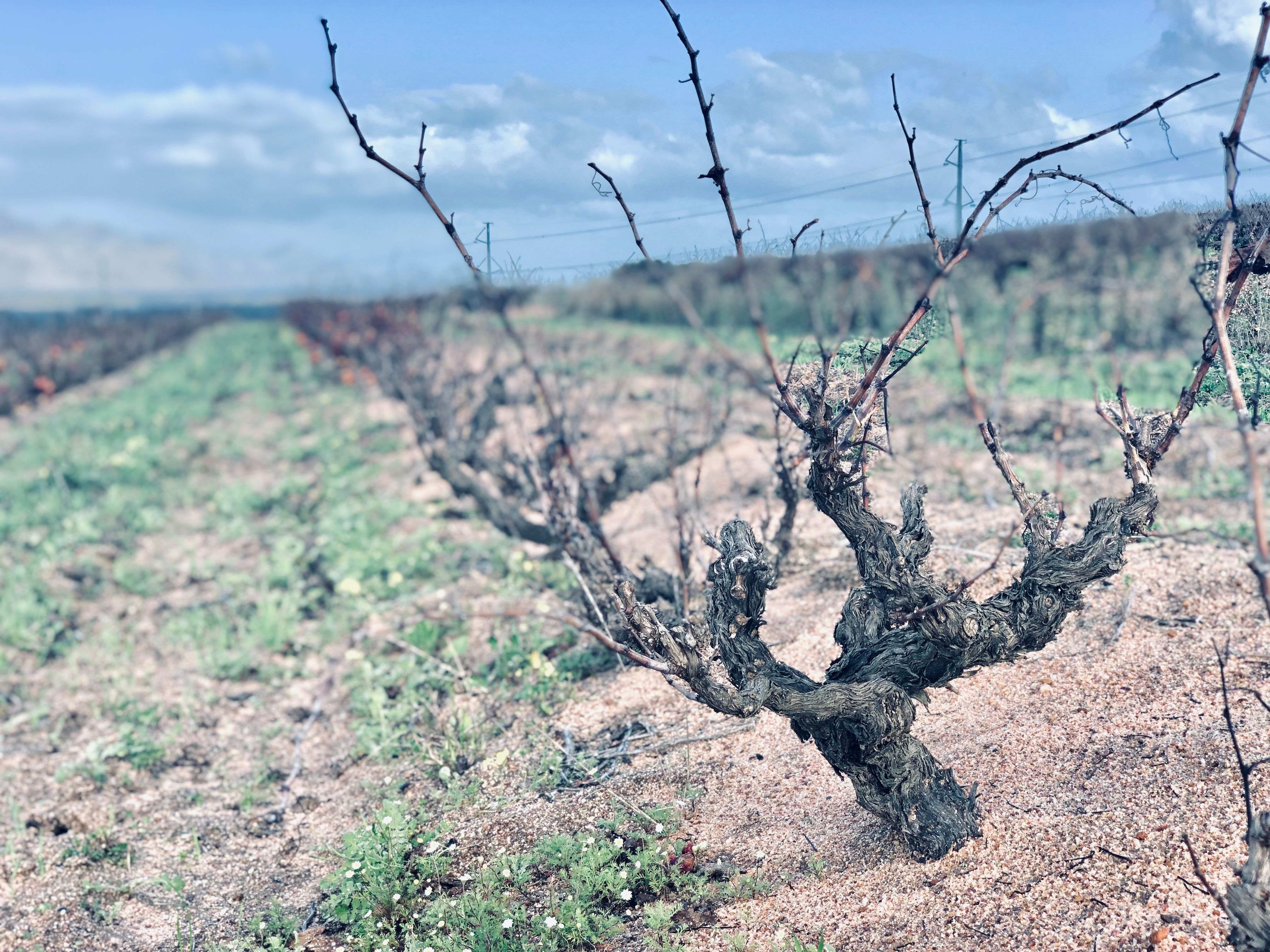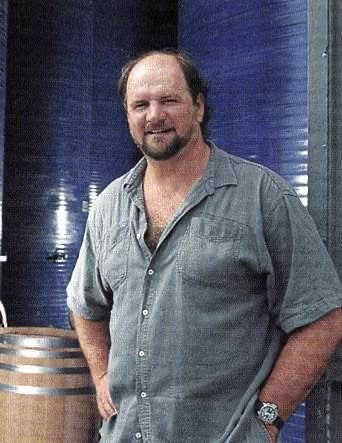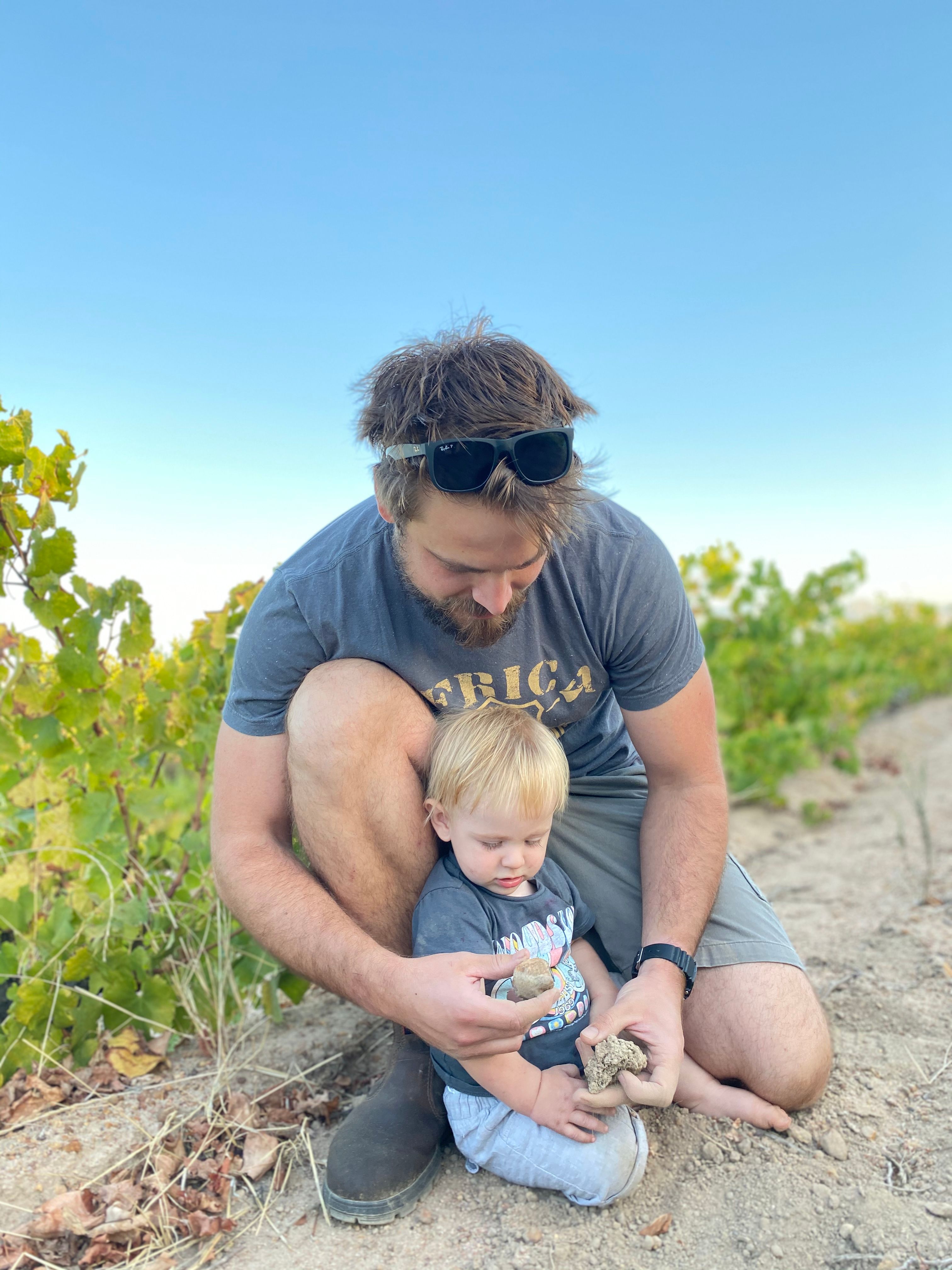Bernhard Bredell digs his hands into the soil of the Granietsteen Chenin Blanc block, planted in 1968. “This is an old trick; if there is life in the soil it should smell like spice—can you smell the coriander, nutmeg?” He asks proffering the crumbling earth, shot through with clover, lupin and mustard flowers. “When there is no cover crop it just smells neutral, like water. An absence of life.”
We’re on the South Eastern slope of Sinai Hill, overlooking False Bay; the ocean is cerulean stripe in the distance, a chilled sea breeze funnelling off it whips around us. Next to the chenin is a cinsault vineyard planted in 1988, the grapes go to the Heldervallei single-varietal cinsault, while the cinsault for the Nomadis blend hails from another vineyard, planted in 1975, in the sandiest part of the area.

Bernhard is a 7th generation grower and producer of the Lower Helderberg. In a tribute to his deep roots here, in both actual vines as well as family heritage, he started his own-label project Scions of Sinai Wines in 2016. The range is made up from five single-vineyard bushvine sites, which were once farmed and owned by his immediate family. He now purchases the grapes, though he takes care of the viticulture.
The Scions of Sinai Wines and the stories behind them all follow the same narrative, respect and preservation of the past, for future generations. The name reflects this commitment to both land and family: a ‘scion’ being both the upper part of the vine or a young shoot as well as a generational descendant.
Sinai Hill is about 12 clicks from Stellenbosch mainland, and from this unique perch you can see the kingdom laid out in 360-degrees, ringed around us are the peaks of the Simonsberg, Jonkershoek, Hottentots Holland, and off into the distance the Schepenberg. And while much of Stellenbosch gentrified, adding tasting rooms and restaurants to wine farm offerings, the Lower Helderberg has remained rooted in farming. “We often forget that wine is a product of agriculture,” says Bernhard. “A natural product made from grapes grown in a certain soil and environment which we can’t take for granted.
“I grew up in these vineyards with my grandfather.
“My grandfather [Koos Bredell] was a huge mentor for me and my family, not just in agriculture and vineyard knowledge but as a person with exceptional moral standards and kindness,” he shares. “He was always in the vineyards he planted, even after retirement. My grandfather believed that the best fertiliser for the vines was his footprints.”
Bernhard has picked up the baton from his grandfather and is continuing his work in the vineyards. A self-confessed soil geek, he completed his BSc degree in Oenology, Viticulture and Soil sciences at the University of Stellenbosch, after which he worked for a few local producers, among them the forward-thinking winery Radford Dale, as well as some harvests abroad in France and Spain.


“If you have balance in the vineyard, you have balance in your wines. The Helderberg has loose granite soils which is good for water infiltration, which is in turn good for old vines. Well-drained granite soils result in vitality. If the roots of a vine are healthy, the grapes will be stable in purity.
“It’s important to oxygenate the soil. When the soil is reductive the grapes express themselves much later. Because of how I farm our grapes ripen a bit earlier, so we pick just before the annual heatwave – when the fragrance of the grapes is in the skins.
“Long hang times can damage the vineyard’s immune system, resulting in all kinds of issues including things like leaf roll. I want to avoid that.”
To this end the day of harvest is important to him, on every bottle he states the date of picking.
We leave the chenin and the cinsault, in search of Féniks, a block of single-vineyard pinotage. Driving around the area with Bernhard, memories constantly bubble up. Of him four-years-old traipsing the hills with grandfather, of drinking red wine in the vineyards as a teenager with his best friend who still lives close by; of helping his dad do punchdowns in the cellar for JP Bredell Wines, which was at one point the largest port producing estate in the world.
We get to the pinotage with a sea view. The bushvine vineyard was planted in 1976 by his father and grandfather, and is located just 3.5km from the ocean, the closest such registered vineyard in South Africa.
“The yields are very low, and I approach the wine more as a Gamay than say a Cab.”
The final stop is the Swanesang Syrah Vineyard, located just behind his family’s old homestead. It’s one of the last (if not the last) remaining syrah bushvines in the Helderberg, and also the closest to the ocean. Planted in treinspoor (train tracks) in 1996, it’s the youngest of the five vineyards, and produces expressive grapes of bright clarity.
Where his grandfather has influenced him in vineyard practices, his father ingrained in him traditional cellar practices.
“I grew up with old winemaking heritage. My dad’s bed was always in the winery! My father, Anton, was also known as the ‘tall guy wearing a bandana’. He was a well-known ‘90s red wine maker and port producer, he took over from my grandfather in 1988. He was innovative and hardworking in the cellar as well as business. He later got recognition for his Bredell's Port from the famous Symington Port family, and developed a friendly bond with them.

“I learnt the ropes of cellar work and winemaking from him, alongside my brother, from the age of six, basically when we were tall enough to be allowed in the cellar during harvest.” During fermentation CO2 fills the winery and if your head is not above that invisible blanket, you can slowly suffocate, making it a dangerous space for toddlers.
Bernhard rents a small stone cellar, also in the L. Helderberg. His approach is natural winemaking: “I’m not trying to be different – I just want to have that line between vineyard and glass as uncompromised as possible,” he explains.
The wines all spontaneously ferment in open-top fermenters, free run juice or an old basket press is used. Only older oak barrels are used for maturation of varying sizes for varying times. Whites all enjoy some skin maceration. The wines are bottled unfiltered and unfined.
“Sanitation and cleanliness in the cellar is key and a borderline obsession. The only additive I value is minute amounts of sulphur, little to none at crushing and some a few days before bottling.”
His maternal grandfather has also had an influence on him. Bernhard Lüttich was a winemaker for Windmeul Co-op from 1962 till 1995.
“My family have all inspired me. I still try to learn from their ways today.
Bernhard married to Monique, is now a father to young Noah: an 8th Generation Scion of Sinai Hill.
His mission Bernhard says is to get the vineyards demarcated so that the next generation can work with ‘the special stuff too’. “We don’t own these vineyards, we’re borrowing them from the next generation”
Just like his dad, Noah is starting off in the soils and vineyards of the Lower Helderbeg; though he’s not quite tall enough for the cellar, just yet.

- By Malu Lambert